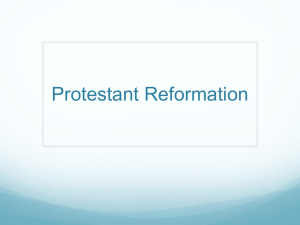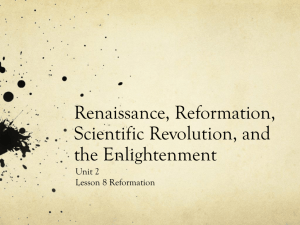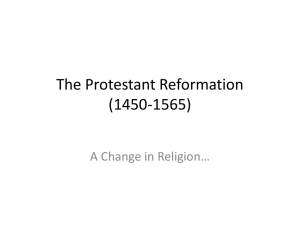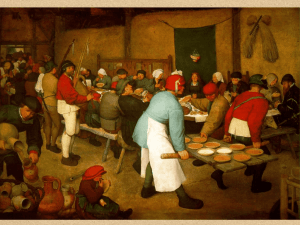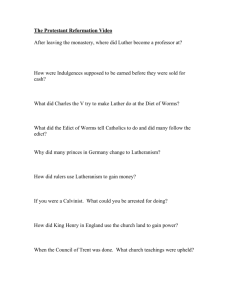Chapter 16: The Reformation in Europe
advertisement
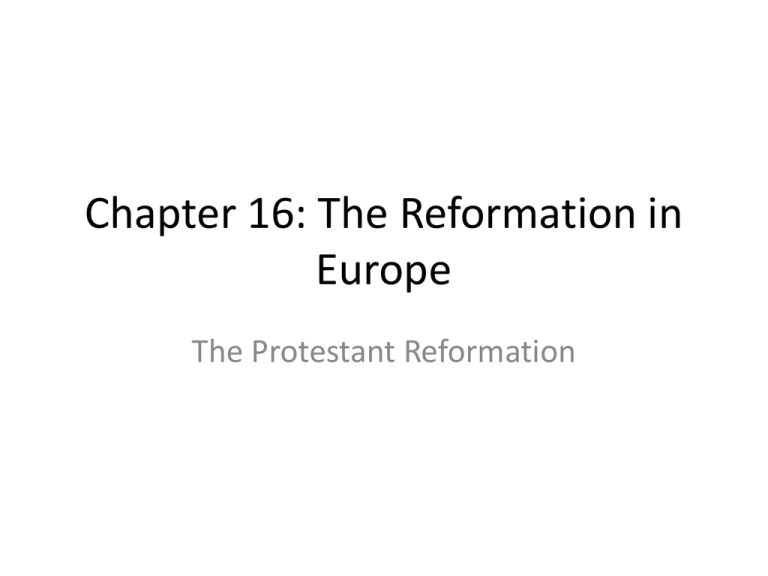
Chapter 16: The Reformation in Europe The Protestant Reformation Prelude to the Reformation • What led up to the Reformation? – Christian Humanism • AKA Northern Renaissance humanism • Combined the classic renaissance ideas with goals of reforming the Catholic Church • Classics would include the Bible • Erasmus – Believed Christianity should also show people how to live good lives on a daily basis – Did not believe in pilgrimages and relics – Criticized the Church in hopes of reforming it Why was Reform Needed? • Popes had negative image – Viewed as more concerned with politics and wealth than helping the people • Local priests were not able to provide proper spiritual help – Unaware of the needs of the people • Increase in indulgences given to wealthy people – Idea was to make money by selling relics to wealthy – Relics were designed to reduce amount of time in purgatory • Rise of Modern Devotion – Stressed importance of teachings of Jesus and less of Church Martin Luther Who was Martin Luther? • • • • 1483-1546 Monk in the Catholic Church Professor at University of Wittenberg Philosophy on Salvation – Humans were saved by their faith in God – Had nothing to do with good works like the Church preaches – Became the driving philosophy of the Reformation – The Bible is the only valid source of truth Luther’s “Ninety-Five Theses” • Posted on October 31, 1517 • What was the purpose? – – – – Attack on the church Luther was against the selling of indulgences Used to pay for construction of St. Peter’s Basilica Believed that indulgences did not forgive sins Luther’s 95 Theses Rise of Lutheranism • 1520 – Luther asks for all German princes to break away from the Catholic Church – Attacked the system of sacraments • Believed in only Eucharist and baptism • Believed clergy marry • 1521 – Pope excommunicates Luther – Edict of Worms • Declared all works and actions of Luther illegal • Burned all documents Rise of Lutheranism • German rulers quickly embraced Luther’s views – Not for religious but political purposes – This solidified the view that the government and not the pope/Catholic was in charge and made decisions • Lutheranism – Luther set example by marrying former nun • Provided model for marriage and family life of clergy • 1524- Peasants’ War – – – – Peasants wanted Luther to be their leader Told them to support the lords’ not him Lords called by God to rule Lost great favor with them Chapter 16: The Reformation in Europe Spread of Protestantism Protestantism in Switzerland • Peace of Augsburg (1555) – Ended Christian unity in Europe – Recognized the break off between Protestant and Catholic in Germany • Ulrich Zwingli – Leader of Protestant movement in Switzerland – Priest in Zurich – Different from Lutheranism but still had same basis of change to Catholic Church Protestantism in Switzerland • Zwingli’s Reforms – Remove all paintings from church walls – Walls will be painted white – Catholic Mass • Replaced with by different sermons – Sought alliance with Luther • Could not agree on sacraments Protestantism in Switzerland • October 1531 – War breaks out between Catholics and Protestants – Protestant army no match for the Catholics – Zwingli’s Fate • • • • Captured Cut up into pieces Pieces burned Ashes are scattered – Fate of Protestantism in the hands of John Calvin Protestantism in Switzerland • John Calvin – Institutes of the Christian Religion • His understanding of the Protestant faith – Beliefs • Justification – One must be deemed worthy by God • Predestination – Some people were chosen to be saved while others were chosen to be damned – Can’t be certain of one’s salvation Reformation in England • Completely unique from all others in Europe • English Reformation based off politics • King Henry VIII – Wanted to divorce his wife Catherine of Aragon • She failed to give him a male heir to the throne • Asked for annulment from Pope Reformation in England • Henry VIII – Turns to Archbishop of Canterbury for help • He agrees to give annulment • Proceeds to marry Anne Boleyn – She gives birth to a girl – 1534: Act of Supremacy • England broke away from Catholics • Henry named “only supreme head on earth of The new Church of England” The Anabaptists • Beliefs of the Anabaptists – Complete separation of church and state – Refused to run for office or carry weapons and fight – Adult baptism • Converts had to understand and voluntarily get baptized – Each church in religion chose their ministers • Anyone could be chosen • Women could serve but rarely did Catholic Reformation • AKA The Counter Reformation – The Catholic response • 3 elements defined it – 1. Established the order of the Jesuits • St. Ignatius of Loyola – Vow of absolute of obedience to pope – Established catholic schools – Used education to get message across Catholic Reformation • 3 elements defined it – 2. Reform of the papacy • Pope Paul III – Called for reform of Renaissance popes – Too many financial disasters – Established Reform Commission » Church problems blamed on Popes » Corrupt policies the basis of it Catholic Reformation • 3 elements defined it – 3. The Council of Trent • Ran from 1545-1563 • Met periodically • Final Decrees – Reaffirmed catholic teaching – 7 sacraments upheld – Both faith and good works needed for salvation – Celibacy expected of clergy – Belief in purgatory and indulgences upheld – Selling of indulgences was illegal
